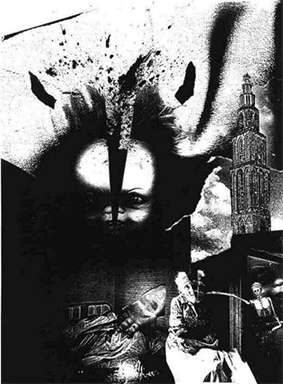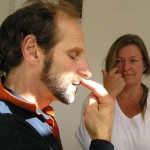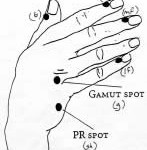The dark side of a psychotherapeutic cult
Video Gestalt in Holland
by Rob Nanninga – Original Dutch version in Skepter 8.1 (1995)
Officially, the IVG is a psychotherapeutic institution, specialised in serving victims of incest. In reality it has more in common with a cult, led by a paranoid woman. How is it possible that the Social Service referred patients to her for years and paid hundreds of thousands of guilders for their treatment?
 The Institute for Video Gestalt Therapy (IVG), located in the heart of Groningen, is led by Wies Moget, a self taught therapist for incest victims. New clients are first subjected to a video screening. They are required to say words such as “papa” and “mama” while a video recording of their face is made. Moget claims to be able to make a very reliable diagnosis on the basis of the recorded images. Incest victims can be recognised by “shock eyes” or by a kind of dazed look that flashes momentarily in their eyes. The latter is so subtle that it can only be observed by Moget.
The Institute for Video Gestalt Therapy (IVG), located in the heart of Groningen, is led by Wies Moget, a self taught therapist for incest victims. New clients are first subjected to a video screening. They are required to say words such as “papa” and “mama” while a video recording of their face is made. Moget claims to be able to make a very reliable diagnosis on the basis of the recorded images. Incest victims can be recognised by “shock eyes” or by a kind of dazed look that flashes momentarily in their eyes. The latter is so subtle that it can only be observed by Moget.
Wies Moget (52) graduated from a College of Social Work in Amsterdam before following a course given by the controversial American therapist Barry Goodfield, who claims that the unconscious can be seen through non-verbal behaviour. By means of a video camera he tracks down repetitive, involuntary movements which are interpreted as symptoms of underlying trauma. Goodfield is principally interested in tracking down all kinds of birth traumas. In the course of therapy the traumatic experiences are relived under hypnosis in order that the repressed emotions can be released.
The IVG has a good reputation in Groningen. More than a hundred clients of the local social services have been referred to the institute. Although the cost of psychotherapy is not covered by social security payments, an exception was made for Moget. If she advised a course of treatment at the IVG not covered by the patient’s health insurance the bill was paid by the social service. For the last three years written instructions to this effect have been issued to civil servants of the social services. Other institutions were informed of this and referred victims of sexual violence to the IVG.
How did the institute achieve this privileged position? What exactly does Wies Moget do?
The Prime Minister
Throughout the 1980’s Moget maintained contact with about a dozen young Goodfield therapists who had, for varying lengths of time, worked in the practice she had opened in Veendam (near Oude Pekela). These therapists were impressed with the experience and skills which Moget had apparently acquired and they appreciated her warm interest in their own problems. Gradually, however, they discovered that Moget possessed a number of negative traits, which became more apparent over time.
Firstly, she had a pathological inclination to tell fantastic stories. During one workshop she surprised everyone by reporting that she had killed a mother and child in a car accident on the way to the workshop. One of the workshop attendants became suspicious and later discovered that the accident had never taken place. Moget also claimed that she had won a professional competition in Zeist between a number of therapists. The (former) Prime Minister of the Netherlands, Ruud Lubbers, and the minister of foreign affairs, Hans van den Broek, had secretly been patients of hers in therapy. Queen Beatrix was a former personal friend, and a wealthy Egyptian had left her several millions which she had donated to a development assistance project in Bangladesh.
Most of the therapists were able to live with the fantasy stories of Moget; they went in one ear and out the other. They had more difficulty with her dominant and manipulative character. Moget would not tolerate any criticism, demanding complete loyalty. New recruits were initially praised and complimented out of all proportion, only to be mercilessly torn apart later. To prevent the victims of her criticism from finding support among themselves she played one against the other. When Moget opened the attack on one of her followers during a staff meeting the others felt obliged to follow her example. Upon completion of such a ’tribunal’ the victim was required to embark immediately on a course of hypnotherapy in order to work on their faults.
Hooked
Many therapists had great difficulty liberating themselves from the clutches of Moget. Those who left were told that they had never possessed the necessary moral fibre for their work. The story told by Kees is indicative of her workwise. Kees had been a youth social worker when he first met Wies Moget. She convinced him that he could become an outstanding therapist. Kees then followed a course by Barry Goodfield and in 1990 started working for Moget. A year later he had left, disgusted.
“Wies advocated her expertise so emphatically that I began to feel humbled in her presence. She did the same thing with her clients. She made videos of their faces and claimed that she could see exactly what the cause of their problems was. The clients believed blindly in her authority and then they were ‘hooked’ as she put it. I have seen her tell clients shocking things that were supposed to have happened to them. When they had no memory of these things Wies would claim they had repressed it all. Her judgement was unassailable.”
Moget confided all her traumatic experiences to Kees. “She had been indescribably sexually abused as a child and tortured with soldering irons and such like. She’d had countless abortions and miscarriages. She survived a number of serious car accidents and had been miraculously cured of cancer several times. She also told me many fantastic stories about her exceptional talents. She claimed, for instance, that she had been a very gifted artist until a mysterious illness made it impossible for her to paint.”
Kees noticed that Moget wanted to take control of his private life and have him at her beck and call. “She tried to convince me that I should leave my wife and children and buy a house in her neighbourhood. Many people, including patients, lost their partners because Wies interfered in their relationships. Luckily I left in time. Later I heard that Moget had told others that I have been fired because I was having a sexual relationship with a client. That is an absolute lie with which she is trying to discredit me.”
Nerve Gas
At the beginning of the 1990’s Moget had lost almost all of her followers and her certificate had been withdrawn by Barry Goodfield. Apart from her new friend and companion, the young Frenchman Vincent Schocron (who had previously operated cameras for Barry Goodfield) only one therapist, Peter, remained faithful. He had to pay for his loyalty when Moget accused him of sexually abusing her two daughters, both ostensibly abused by their father before that. Even though Peter was unable to remember anything of the alleged events, and furthermore is homosexual, he permitted Moget to convince him of his repressed past. He even reported to the police vice squad twice. Luckily the detective who spoke to him did not take his confused confessions seriously.
Since 1991 Moget has trained her own therapists. She selected students for her courses from among her clients who were in therapy. They paid her 5000 guilders for thirty days of training. In the second year of their training they were employed as unpaid therapists in the booming video gestalt practice which had been started in Groningen. A number of qualified teachers who were initially associated with the course were dismissed. The second select group of students received lessons from the first group of recruits.
In 1992 Moget informed the students that she was being persecuted by a criminal sect of Satanists. Her ex-husband was said to be a member. Psychiatrists, police and doctors were also involved, according to her. She claimed that these shadowy figures, “The Group”, as she called them, had tortured and ritually abused her two daughters. Memory of these traumatic experiences had been recovered by means of hypnosis. Sophisticated alarm systems had been installed in her home in Veendam and in the practice in Groningen in an effort to keep the Satanists out.
With the help of a psychic who used a pendulum Moget was able to identify more and more Satanists. Some of the students were told that a spy, programmed by The Group, had penetrated their number. The suspected person was forced to subject herself to hypnosis in order to become conscious of her sins. However, when she was not able to remember all the events Moget wanted to hear she was expelled from the practice in a state of disgrace.
On several occasions the students were unable to progress with their course because Moget, with Vincent and her daughters, had fled in panic to another country. She told them that her house was about to be attacked with nerve gas and that her telephones were tapped. By the end of 1992 various students withdrew from the course when the atmosphere had become very threatening. Six students remained, including Moget’s two daughters. Moget believed that these faithful, all of whom worked in her practice, had all been subjected to torture and ritual abuse by The Group. They lived under clouds of imaginary danger; especially on satanic feast days when it was thought too dangerous to walk about the streets and all therapists gathered in Moget’s home.
Electroshocks
After the psychic had withdrawn her paranormal services her role was taken over by Linda, Moget’s youngest daughter. She was able to make contact with a spiritual guide who, during seances with her mother, whispered the names of the guilty. Linda ended her medical studies because she no longer felt safe in the hospital. Doctors were said to have given her electroshocks and had held her head underwater in the swimming pool. Together with her boyfriend she returned to live with her mother in Veendam. Her older sister broke of her relationship with her boyfriend and returned home alone.
In February 1993 Linda told the parents of her boyfriend that she had been abused by three men. In fact she had been alone with her mother at home at the time. She accused her father, the ex-therapist, Peter, and a doctor who had previously treated her mother. The father of Linda’s boyfriend reported the stories to the police who in turn visited Wies Moget. The detectives were under the impression that the stories of abuse were Linda’s fantasies but were not able to investigate further since neither Linda nor her mother wanted to make a formal complaint.
Marloes, one of the students who had started working in the practice, was told by Moget that her husband, father in law and best friend were members of The Group. Marloes withdrew almost completely from her normal social circles and left her husband. In February 1994, however, she began to doubt Moget’s stories since she had been unable to find any concrete evidence of the alleged dangers. Moget accused her of failing her duty as mother in view of her inability to see the dangers to which she exposed her daughter. In order to provide optimum protection Moget took Marloes and her daughter into her home, after which neither were permitted to leave the premises.
Moget often told Marloes that she had seen men sneaking around her house at night. She installed hundreds of meters of barbed wire. She claimed that the rooms of the practice in Groningen were used by The Group for satanic rituals in which her clients had participated. As evidence she presented a telephone bill ostensibly demonstrating that calls had been made after closing hours.
Programmed
Because it was believed that The Group converted victims into abusers the atmosphere among the students became very tense. Everyone had to watch their cups of coffee carefully to prevent others from drugging them. Moget maintained that her confidants had been programmed by the Satanists to react to certain triggers, such as a ‘whistle’ sound coming in through the window. These triggers would shut out their normal consciousness and activate a programme that the Satanists had placed in their brains. Moget claimed to have rescued her daughter several times as she tried to leave the house at night in trance.
Group therapy sessions were held twice a month in which all students and colleagues were expected to participate. During these sessions hypnosis was used to recover memories of abuse. Moget’s daughters, who had read many books on the subject, were able to describe in detail how babies had been offered in sacrifice to Satan. They recalled being raped by one of their colleagues. He, in turn, received hypnotherapy sessions in order to become conscious of his ‘darker side’ and was deprogrammed to prevent his return to the Satanists. In addition an increasing number of clients began to recover memories of ritual abuse after having been identified by the Moget family as victim/perpetrators.
During the hypnotherapy sessions Marloes saw how babies had been hung upside down and heard the Satanists tell her that her daughter would be tortured unless she obeyed their commands. Moget wanted more details in order to take the information to the police. However, Marloes had difficulty producing any evidence or likely leads to support her grotesque fantasies. By the end of September 1994 she had finally decided to reject the delusions of Moget. She was fired on the spot.
A burned up baby
In the most recent brochure of the IVG it is stated that the institute specializes in the treatment of ritually abused women. The account of Mieke, a former client, illustrates how this specialism is practised.
“A girl friend of mine had been referred to Moget. I also wanted to go since the regular social workers were not able to help me with my problems any further. At Social Services they told me they agreed. All I had to do was get a referral from a doctor at the Community Medical and Mental Health Service. The first time Wies made a video recording of my face. I was stunned of the things she was able to get out of the recordings. She also told me a whole story about a psychiatrist who had been in therapy under her. I had to do a workshop every fourteen days. We lay on mats on the ground and were brought under hypnosis. There were two students sitting alongside each mat who were supposed to be our guides.”
“Wies asked me if I had ever been given electroshocks or been injected with drugs. She could see that by the way I lay on the mat. When I said that I didn’t know anything about that she told me a story of a client who was only able to remember in her forties. Wies thought that it must have happened in my puberty. She told me that there were drugs that could completely wipe out your memory. I was panic struck because indeed I couldn’t remember some of my youth because my boyfriend had committed suicide.”
It was difficult for Mieke to get visions under hypnosis in the beginning, but gradually the visions became more vivid. “The visions were terrifying, all about sexual abuse in my childhood. I recognised that they were not real events and didn’t know what I should do about them. The therapists said that I must accept the visions as true, otherwise I would never be cured of my neurosis. During one extra long workshop I saw flaming torches and saw myself tied down to a table. I saw a burned up baby and the Wies said: ‘Now we are getting at the core.’ I panicked completely and didn’t want to go on. I just couldn’t imagine that this all really happened. They kept telling me that I had to look the truth in the eye. That was the only way in which I could be cured.”
When Mieke finally realised what was going on at the institute she stopped with the therapy. Retrospectively she realises that the visions were induced by the collective fear of her therapists. “They had become specialists in their own fears and communicated them to their clients. If I had stayed there any longer I would have come completely under their influence. At the time I trusted them more and more because I really wanted to be cured of my problems. There are many patients walking around now who are completely dependent on the institute.”
Six figure payments
From a specified account supplied by an ex-client of the IVG it can be seen that already in 1990 the Social Service in Groningen was paying thousands of guilders to Wies Moget. Extrapolation from the known figures indicates that six figure payments must have been made by the end of 1994. The client related that she was terrified of Wies Moget who had insulted and degraded her. She had reported to her contact civil servant that the practice of Moget was not in order; appointments were not being kept and therapists suddenly left. But the Social Service had not reacted to her complaints.
How did Moget establish such a good reputation? How is it possible for a paranoid woman with a pathological fantasy who terrorised those around her to enjoy so much confidence from the Social Services that she was elevated to a special status with respect to financial support? People who knew her said that she had established outstanding contacts with the Social Services but when and why the special instructions were given remains unclear. Unfortunately, the clients had little choice because standard psychological therapy was not covered by medical insurance or the Social Services.
Early in February 1995 the director of Social Services in Groningen was informed in writing of the situation by the author. Initially, the management refused to comment on the case. Mr. N. de Jonge, head of the complaints commission of the Social Services, referred the author to a doctor of the Community Medical and Mental Health Service, who was allegedly investigating the complaints. This doctor, however, was unable to say anything about his investigation and was also not interested in receiving information. Later Mr. de Jonge admitted that “the investigation had come to somewhat of a stand still, so to speak.” The Social Services had decided to wait for developments for the time being. According to Mr. de Jonge, the city hall would take action only if they were forced to, for example, through media attention.
In the mean time a number of ex-students also tried to do something to stop Moget. Many of them claimed to have been seriously damaged by Moget and her methods but did not have the courage to challenge her. It was only after they heard that they were not alone that they were willing to report their experiences to the Inspectorate of Health. However, they were told that the possibilities available for intervention were limited.
Non-recognised
On the third of March 1995 an earlier version of this article was published in a Dutch academic weekly. The Social Services of both Groningen and Leeuwarden then decided not to refer any more patients to the IVG. According to the Social Services they were awaiting the result of a report by the Regional Health Inspectorate.
Contradicting this, however, Mr. Van Veldhuizen, regional inspector of health, reported that the Inspectorate does not have the authority to investigate the IVG in view of the fact that it is not a recognised institute. “As long as I am unable to initiate any investigation I can only say that the IVG is not recognised. The law is very liberal in this area. If this freedom leads to abuse then the matter can only be addressed by exposure in the media.” Van Veldhuizen did agree that referrals to non-recognised institutes was unnecessary. “If a recognised institute associated with a disciplinary college and commission for examinations exists then why go to someone around the corner who does not have that? That is a question I shall be putting to the Social Services.”
Two weeks after this discussion the Social Services in Groningen still claimed to be waiting for an advisory report from the Inspectorate. According to a spokesperson, the Inspectorate would be bringing out an advisory report within days. However, this was emphatically denied by inspector Van Veldhuizen. Finally, after a second article about Moget had been published in a national newspaper and a current affairs programme had shown two of her victims on TV, the Social Services decided that no further payments would be made to non-recognized therapies.
The IVG will not answer any questions. They regard themselves as the victims of slander and have taken the author to court. The matter will be fought out before a judge.
Sources: Intermediair, 3 March 1995; Trouw, 18 March 1995
Translation: Benjamin Rossen
Postscript
On December 15, 1995, the court turned down Moget’s claims and sentenced her to pay for the legal proceedings. According to the judge, I had enough evidence for my allegations (sixteen testimonies) and publishing these facts had been my only option to prevent greater damage.



